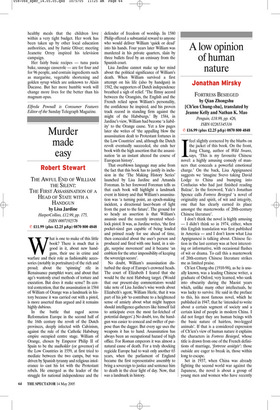Food for plutocrats and the people
Elfreda Pownall
GRAND LIVRE DE CUISINE by Alain Ducasse Stewart, Tabori & Chang, £159, pp. 1080, ISBN 2848440007 THE NEW ENGLISH KITCHEN by Rose Prince Fourth Estate, £18.99, pp. 468, ISBN 0007156448 THE DINNER LADY by Jeanette Orrey Bantam, £16.99, pp. 259, ISBN 0593054296 ✆ £14.99 (plus £2.25 p&p) 0870 800 4848 If a Martian were to read these three recently published cookery books, his postcard home would conclude that for Earthlings money is the root of all cooking. Alain Ducasse’s Grand Livre de Cuisine is huge and enormously heavy, (it weighs 111/2 lb). Ducasse is considered by his peers one of the three greatest chefs of the 20th century (with Fernand Point and Paul Bocuse). He has been awarded three Michelin stars for two restaurants at once (the Louis XV in Monte Carlo and the Plaza Athénée in Paris). The 648 recipes in his book, all set out in alphabetical order by main ingredient, are wonderfully sophisticated, calling for such ingredients as 12 cockscombs, 12 rooster kidneys (notice that the sex of the bird is specified), ‘wild wood pigeons from high in the Pyrenees’ and ‘olive oil pressed from very ripe olives’. A self-sufficient peasant might once have produced these things, or a king ordered them (indeed the book’s introduction cites peasants, fisherfolk and royal households as the fount of cooking), but these days, very few people outside Michelin three-starred restaurants will ever taste them.
So who is this book for? Not the domestic cook. It is more likely to become an object of veneration for other chefs. (This certainly was the fate of Ferran Adria’s El Bulli. I once saw three chefs poring over it, before it was translated from the Spanish, understanding not a word, but sighing at the pictures.) There are few recipes in Ducasse’s book that even the most confident amateur could pull off, and in any case few could afford to. One sauce, for eight people, calls for 9lbs clams, 33lbs cockles, 3lbs razor clams and 2lbs of periwinkles, and the tiny black batons sprinkled on many of the dishes are cut from black truffles.
Ducasse does, however, give readers many pointers to reproducing his work. The instructions for serving and presentation are precise, and the photography, beautiful and pin-sharp ( although it serves only to show how far one’s own attempts have fallen short of the master’s perfection). All in all, the book is a wonderful inspiration: to know that such things are made and to attempt some of them is a real pleasure. Ducasse has produced a historic record as important for future generations as Robert May’s The Accomplisht Cook (1660): the work of one of the world’s best chef, for some of the world’s richest people.
Money motivates Rose Prince too, though her stage is family life. In The New English Kitchen (previously reviewed in these pages), her mission is to show us how to shop, cook and eat well on a frugal budget. Ever since Mrs Beeton food writers have been telling readers how to save money (although few who had tasted the fruit would have been fooled by Beeton’s mock apricot conserve made of carrots), often relying on what Verlaine called ‘l’art profonde d’accommoder les restes’. But Rose Prince cooks so as to ‘make’ leftovers. She shows how a single leg of pork can provide seven meals, or 22 helpings, from the roast joint, through salads and noodles to sandwiches and soup.
Prince’s book is not just a collection of recipes (though hers are delicious), rather a realistic system of eating and shopping for family life. She saves money not by buying cheap, factory-farmed food, but by using the best ingredients cleverly. She shows how the bien-pensant middle classes, aware of the horrors of factory farming and our depleted seas, can afford to eat well — and without the need to spend hours at the stove. My only quibble is with her suggestion that cooked rice can be kept for up to five days in the fridge. Rice can be dangerous after 36 hours, long before it begins to smell foul. But this is an isolated fault in a useful and important book.
Saving money on school dinners has been the main consideration of government initiatives since a White Paper in 1978 targeted a 50 per cent reduction in their cost. Jeanette Orrey, a school dinnerlady from Nottinghamshire, describes the depressing results in her book, The Dinner Lady. Contracts for the supply of school food were awarded on the basis of the lowest cost, and the result was centrally bought, highly processed food full of additives with no fresh fruit or vegetables. In the book Orrey tells the story of her crusade to bring back proper cooking to her own school. It has been a great success; now she sources ingredients locally from (mostly) organic farmers, and cooks healthy meals that the children love within a very tight budget. Her work has been taken up by other local education authorities, and by Jamie Oliver; meeting Jeanette Orrey inspired his television campaign.
Her fairly basic recipes — tuna pasta bake, sausage casserole — are for four and for 96 people, and contain ingredients such as margarine, vegetable shortening and golden syrup which are unknown to Alain Ducasse. But her more humble work will change more lives for the better than his magnum opus.



































































 Previous page
Previous page